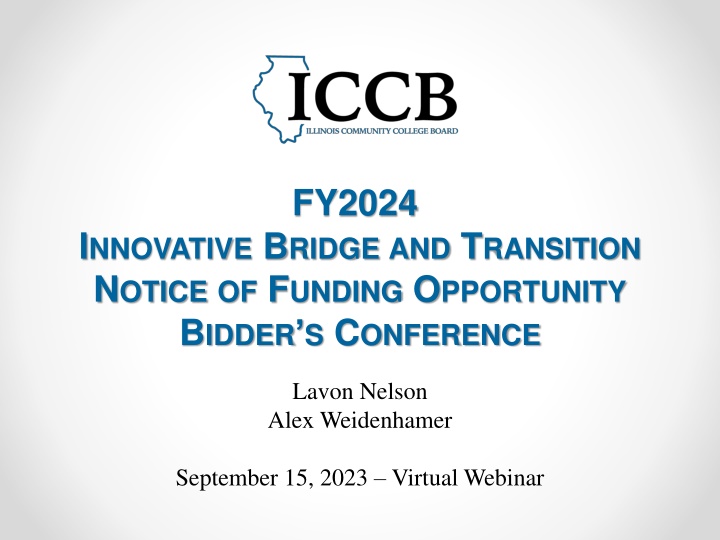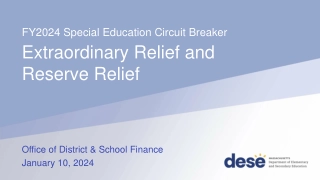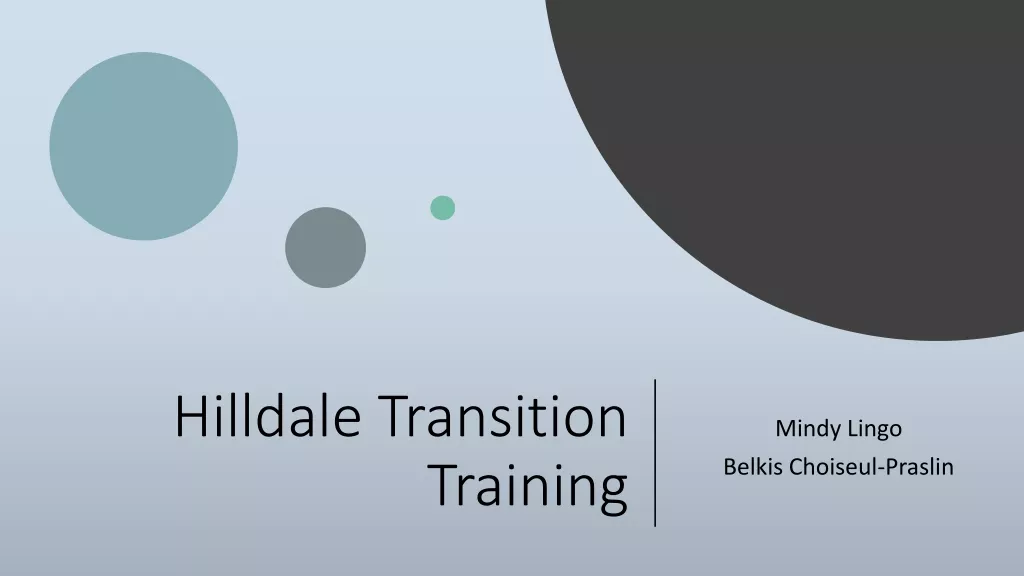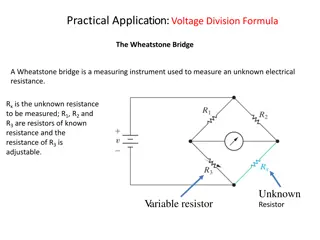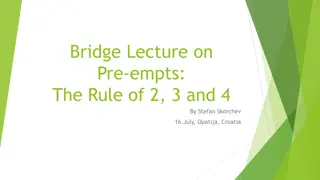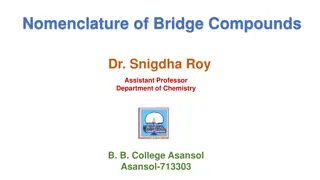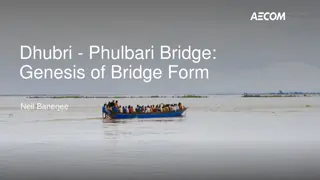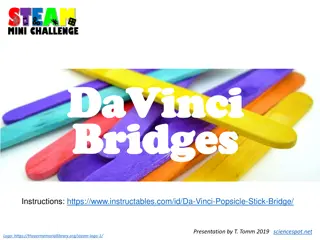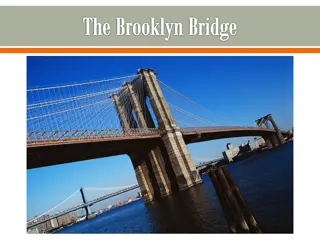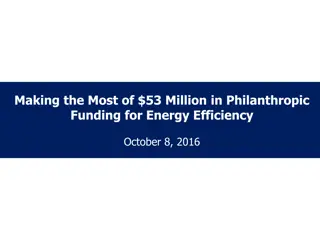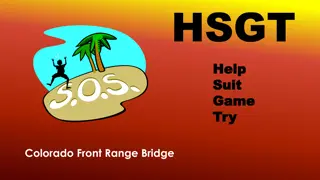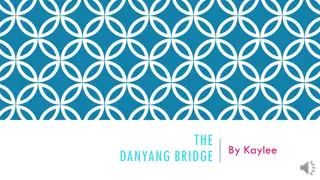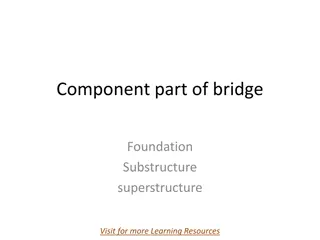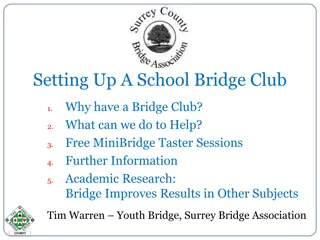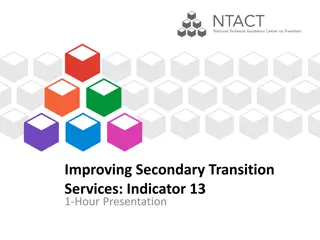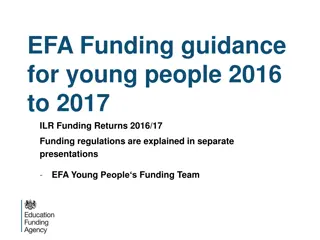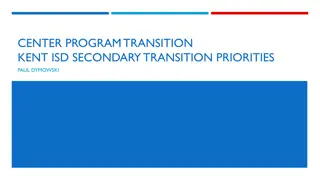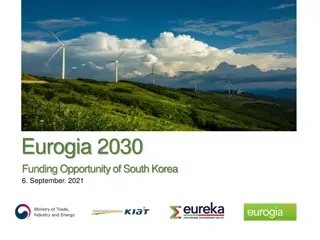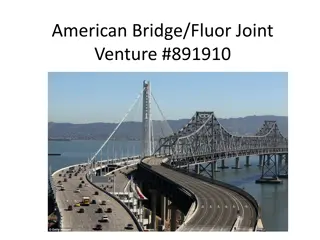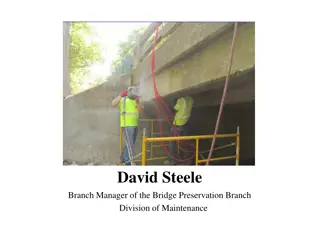FY2024 Innovative Bridge and Transition Funding Opportunity
The FY2024 funding opportunity for Innovative Bridge and Transition programs administered by ICCB. Learn about grant details, eligible applicants, target populations, and the purpose of the grant. This virtual bidder's conference provides key information on funding availability, application process, and program goals for improving student transitions to postsecondary education and employment. Get insights on creating programs that promote equity and diversity."
Download Presentation

Please find below an Image/Link to download the presentation.
The content on the website is provided AS IS for your information and personal use only. It may not be sold, licensed, or shared on other websites without obtaining consent from the author.If you encounter any issues during the download, it is possible that the publisher has removed the file from their server.
You are allowed to download the files provided on this website for personal or commercial use, subject to the condition that they are used lawfully. All files are the property of their respective owners.
The content on the website is provided AS IS for your information and personal use only. It may not be sold, licensed, or shared on other websites without obtaining consent from the author.
E N D
Presentation Transcript
FY2024 INNOVATIVE BRIDGE AND TRANSITION NOTICE OF FUNDING OPPORTUNITY BIDDER S CONFERENCE Lavon Nelson Alex Weidenhamer September 15, 2023 Virtual Webinar
KEY INFORMATION Please enter your name, email and organization into the chat. There will be an FAQ posted on the website. No questions will be answered to individual entities but will be posted to the FAQ page. Please send all questions to IBT.ICCB@illinois.gov The funding is NOT Adult Education funding or Career & Tech Education funding but state funding through an appropriation to ICCB specifically for Innovative Bridge and Transitions. This meeting is being recorded. Please put all questions into "chat" so that we can answer them in the upcoming FAQ.
FUNDING OVERVIEW ICCB was appropriated through the General Revenue Funding approximately $9.194 M to administer grants that support Innovative Bridge and Transition (IBT) programs. Only one grant application per institution. Maximum Amount per Grantee: $400,000. Grant period: January 1, 2024 December 31, 2024
PURPOSE OF THE GRANT Create or support programs that improve student transitions to and through postsecondary education (up to post baccalaureate) and into employment or programs that support these transitions for individuals with disabilities; and Scale programs that promote equity and diversity among those served.
ELIGIBLE APPLICANTS Institutions of Higher Education Community-Based Organizations Local Education Agencies Public or private nonprofit agencies Comprehensive rehabilitation facilities associated with a university or institutions of higher education Other applicants of demonstrated effectiveness in serving the eligible population
TARGET POPULATIONS 16 years of age or older: Adults who are not enrolled in high school Youth who are in school preparing to enter postsecondary education or training programs Out-of-school youth 16-24
ADULTS NOT ENROLLED IN HIGH SCHOOL Adult who have limited academic or basic skills, underemployed or unemployed to enter and succeed in credit-bearing postsecondary education and training leading to employment in high skill, high wage, and in- demand occupations.
YOUTH WHO ARE IN-SCHOOL Serving in-school youth is an allowable activity only if the services to this population prepares them to enter into postsecondary education and training following graduation.
OUT-OF-SCHOOL YOUTH Aimed at helping this population become reoriented and motivated to complete their education by allowing students to participate in education as well as career and work-training activities. The overarching goal is to assist students in achieving high school completion or a High School Equivalency credential as the basis for entry into postsecondary education/training and meaningful employment. One way to do this is by incorporating an Integrated Career Academic and Preparation System (ICAPS) model.
GRANT OBJECTIVES and ACTIVITIES
GRANT OBJECTIVES MUST SELECT ONE AND IDENTIFY IN THE APPLICATION Objective 1: Adult Education Bridge and Integrated Education and Training Programming: Create new and greatly expand bridge or integrated education and training programming, which shall include contextualized basic reading, math, and language skills, occupational competencies, and employability skills. This objective shall not supplant required bridge and IET activities under WIOA Title II, Adult Education and Literacy FY2023 implementation. Objective 2: Seamless Transitions for College and Career Pathways: Implement programs that provide seamless transitions from high school to college or between postsecondary institutions, including but not limited to: curriculum alignment between secondary and postsecondary institutions, curriculum alignment and articulation efforts between postsecondary institutions (2+2 agreements, up to graduate level work), dual credit programming, CTE program of study development and implementation, college and career pathway endorsement activities, and pre-apprenticeship to apprenticeship partnerships. Specifically, applicants should consider programs that provide seamless transitions for students, including out-of- school youth, into and through college and career pathways that prepare them for high-skill, high-wage, and in-demand careers.
OBJECTIVE 2, CONT'D 2a-Curriculum alignment between secondary and postsecondary institutions, curriculum alignment and articulation efforts between postsecondary institutions (2 +2 agreements, up to graduate level work) 2b-Dual credit programming, CTE program of study development and implementation, or college and career pathway endorsement activities 2c-Pre-apprenticeship to apprenticeship partnerships and implementation 2d-Out-of-School Youth Career Activities: The program is specifically aimed at helping out-of-school youth (ages 16-24) to become reoriented and motivated to complete their education by allowing students to participate in adult education instruction as well as career training activities.
GRANT OBJECTIVES, CONTD Objective 3: Wrap-around Support Services: Utilize transition/wrap- around services which provide students with the information and assistance they need to equitably access and persist along their career pathway. This may include providing wrap-around services for students transitioning from adult education or remedial coursework to credit or occupational programs, or from credit or occupational programs to the workforce. Services may include academic advising, career pathway navigation, tutoring, supplemental instruction, study skills, coaching, and referrals to individual support services (e.g., basic needs including housing, transportation, and childcare). Objective 4: Seamless Transitions for Students with Disabilities: Create comprehensive programming for individuals with disabilities that provides vocational, psychological counseling, transitional and educational services, and job placement activities for them to live and work independently in the community. These programs may include transitions from high school to college as well as college to employment.
PRIORITY ACTIVITIES TO BE CARRIED OUT IN ALL OBJECTIVES: 1. Engage in partnerships with other entities that may strengthen the ability of students to persist through the education and training provided. Systemic change efforts are encouraged. Partners may include community-based organizations, institutions of higher education, advocacy groups, local one-stops, and employers, among others. Develop and implement career activities which may strengthen career development and exploration, career planning, understanding the world of work, and integration of essential employability skills. This may include work-based learning opportunities (e.g. internships, pre-apprenticeships, apprenticeships, etc.). Implement and integrate equity-driven, evidenced-based practices, strategies, and pedagogy throughout programming. Grantees should utilize data-informed decision-making in the development, implementation, and evaluation of programming to identify equity gaps and address inequities appropriately. Programs should aim to ensure diversity, equity, and inclusion is adequately supported in programming. Specifically, programs should aim to advance equitable access and outcomes for racially and ethnically minoritized communities as well as others marginalized by education and workforce systems. 2. 3.
HOW TO COUNT IBT PARTICIPANTS IN ADULT EDUCATION You are not required to do this! This is not an adult ed program or adult ed funded For planning purposes, consider the following: If you choose to count students as Adult Education students, your Adult Education program must be an ICCB funded Adult Education provider. Any student that goes into Daisi must be pre-tested. This is a Daisi requirement, not a funding requirement. If you are not going to enter students in DAISI, you cannot count them on your adult ed reports. Benefits of doing this: 1. Braided funding multiple sources of funding to help cover the costs of programming 2. Additional Adult Education completion numbers for your Adult Education program 3. Better Performance Outcome for State Adult Education
HOW TO COUNT IBT PARTICIPANTS IN ADULT EDUCATION CONT'D How to plug students in to Daisi: For these purposes, you will need to use funding codes either 4900 or 4910. o 4900 is Unrestricted Funds (such as institutional dollars, personal donations, etc.) o 4910 is Other Restricted Funds (such as other grants from ICCB) - IBT funds would fit in this category. If you have additional questions, please reach out to yourAE Regional Support Staff.
EXAMPLES OF GRANT ACTIVITIES Allowable Activities with various Objectives: The expectation is that applicants will propose activities that will align with statewide priorities around career pathway opportunities and activities that promote equity and diversity; Developing or Aligning Curriculum: Furthering the alignment of coursework by contextualizing and integrating basic skills or academic and career and technical education offerings. This may also include articulation agreements between community college and four-year institutions, curricular alignment activities up to post-baccalaureate level, and competency mapping throughout the pathway. Creating career pathway activities for those youth in their senior year of high school that smooth their transition into postsecondary education or to a training program. Creating short-term training programs that support minority students transition into postsecondary education and employment. Developing African American History programs that teach cultural awareness and historical perspectives. Developing an American History curriculum that teaches cultural awareness and gives an accurate account of history for k-12 in Illinois. Creation of programs and services that assists individuals with disabilities (i.e., those who are on the autism spectrum) to access educational services that will help support their independence and reduce barriers to their success.
MORE EXAMPLE ACTIVITIES Creating a high demand dual credit program from high school to postsecondary education. Developing an integrated education and training program that allows those who are basic skill deficient to earn industry recognized or college credentials, college credit, and credits toward an in-demand occupation. Expanding or developing models that link participants in adult education programs including all provider types and to community colleges. Developing models that promote service integration with partner programs. Developing a bridge program in an in-demand sector. Working with employers to develop a career pathway program that is designed for incumbent workers. Developing a process for using prior learning assessment to evaluate and grant credit for prior learning. Developing a student support center model that will enhance services to underrepresented populations. Creating support services models/toolkits that will reduce barriers to populations and enhance their educational success. Expanding bridge to include an innovative support services program to ensure student success in progressing to and through postsecondary education. Engaging employers in the development of an apprenticeship program for adults in a high demand sector. Enhancing or developing institutional career pathways. Applicants may engage in career pathway development, alignment, and/or evaluation activities to ensure the inclusion of multiple entry and exit points, rigorous and integrated content, or focus on strengthening components which make up a successful bridge or transition program (i.e., integrated education and training program development, curriculum alignment, stackable credentials). Developing work-based learning or apprenticeship models. Developing support services models that include wrap-around services for basic needs including but not limited to housing, financial literacy, and other services that will reduce barriers to educational success for all students including those who are homeless and those individuals with disabilities. Developing comprehensive programs and services for those with disabilities that provide assessment of work strengths, abilities and limitations through an evaluation process which may include but not limited to interviews, testing and observation. These services may consist of providing living center programming such as life skills including budgeting, meal preparation, job placement into compatible competitive employment, professional training and research, driver s rehabilitation services, essential work skills with an emphasis on employer expectations, and other daily living skills that offer residents an opportunity to live and learn new skills and work toward personal independence. Other activities of statewide significance that expands career pathways and is aligned with labor market information as identified by local or regional needs.
SUMMARY OF EXAMPLE ACTIVITIES Applicants are not limited to these example activities. Other activities of statewide significance that expand career pathways and are aligned with labor market information as identified by local or regional needs. Applicant s proposed activities must be in alignment with the grant purpose and objectives. Applicants may propose as many activities as desired. Applicants will be held accountable for the performance outcomes and goals as proposed in their application.
APPLICATION PACKET OVERVIEW Applicants: must include all parts of the application package in the submission. must complete and submit the application by the deadline. November 1, 2023, at 11:59 CST must use the templates provided. One application per institution. Applicants are not eligible to renew or extend existing grant-funded projects but may supplement or scale current initiatives. Application Packet must include a(n): 1. Uniform Application 2. Cover Page (template) 3. Application Narrative 4. Uniform Budget 5. Performance Measures Chart (template)
PERFORMANCE MEASURES CHART Planned Deliverables and Performance Measures Quarter 1 1/1/24- 3/31/24 Planned Quarter 2 4/1/24- 6/30/24 Planned Quarter 3 7/1/24 - 9/30/24 - Planned Quarter 4 10/1/24 - 12/31/24- Planned 5 5 Good Example - Will enroll 20 students Bad Example - Will enroll 50% of all students 5 5 NOT 10% NOT Maybe 5 NOT We thought we would enroll more Bad Example - Will enroll students ? ? ? ? Good Example- Will run 3 classes through the year 1 1 1 Bad Example -Will run classes ? ? ? ?
PERFORMANCE MEASURES, CONT'D Activities are NOT performance measures Examples of performance measures Number of students to be enrolled Number of students to transition to postsecondary education or employment Number of students to complete Number of a specific target population you plan to serve, e.g., unemployed, out of school youth, returning citizens Number of classes to be offered Number of curricula to be developed Number of staff to be hired
APPLICATION PACKET 1. Uniform Application Must be completely filled out o 1stpage is for the ICCB. NA, for questions not applicable 2. Cover Page and Grant Summation (Separate Sheet) Institution s Name Address Telephone Number Website Contact information for: o President/Chief Executive Officer, o Chief Financial Officer, and Project Coordinator/ Administrator o Email address, telephone number and extension, Fax number Cover Page and Performance Measures Chart are not counted in the twelve-page narrative. 1. Awarding Agency Name: Illinois Community College Board (ICCB) Alex Weidenhamer, alex.weidenhamer@illinois.gov; (217)558- 5671 Initial announcement Grant 1670-2031 FY2024 Innovative Bridge and Transitions 684-01-1670 Innovative Bridge and Transitions N/A January 1, 2024 December 31, 2024 30-70 2. Agency Contact: 3. Announcement Type: 4. Type of Assistance Instrument: 5. Funding Opportunity Number: 6. Funding Opportunity Title: 7. CSFA Number: 8. CSFA Popular Name: 9. CFDA Number(s): 10. Grant Period 11. Anticipated Number of Awards: 12. Estimated Total Program Funding: $9,194,400 13. Award Range 14. Source of Funding: 15. Cost Sharing/Matching Requirement: Indirect Costs Allowed Restrictions on Indirect Costs $75,000-$400,000 State No Yes No 16. 17. Posted Date: 18. Closing Date for Applications: September 6, 2023 November 1, 2023, 11:59 p.m. Technical assistance will be provided throughout the grant period to grant recipients. 19. Technical Assistance:
APPLICATION PACKET, CONTD Cover Page and Grant Summation Template The applicant must complete the Cover Page and Grant Summation Template (template provided) which encompasses applicant information and a synopsis of the grant, including but not limited to: Organization background Summary of the project activities and how they align with the goals of the Innovative Bridge and Transition grant. Target population(s) and geographic communities to be served (e.g., ethnicity, gender, socioeconomic status, educational/workforce levels) Projected number of unduplicated individuals to be served Measurable Goals and Objectives.
APPLICATION PACKET, CONTD Cover Page must also include a statement that stipulates: This application is being submitted on behalf of the <institution s name>; and, if awarded, the applicant agrees to abide by the provisions and guidelines set forth in the application and by the ICCB. Furthermore, the individuals listed in the application are authorized to act on behalf of the institution. The statement must be signed and dated by the President/Chief Executive Officer (CEO)
APPLICATION PACKET 4. Uniform Budget Applicants should submit budgets based upon the total estimated costs for the project. Refer to 2 CFR 200, Uniform Administrative Requirements, Cost Principles, and Audit Requirements for Federal Awards cited within the template s instructions Be detailed and specific in completing the budget. Budget items must follow the guidelines set forth in the Education Department General Administrative Regulations (EDGAR). All applicants must submit a proposed budget on the State of Illinois Uniform Grant Budget Template (template provided). Costs should be in line with allowable costs under the Grant Accountability and Transparency Act. For information on allowable uses of funds and other administrative requirements: https://gata.illinois.gov/resources.html
APPLICATION NARRATIVE The eligible applicant must submit a narrative of no more than twelve pages (charts and graphs are a part of the twelve-page limitation), double-spaced, 12-point font that must include the following information in the order listed below and utilizing a header for each Numbered Section. Narrative Sections I. Statement of Need: a description of the target population of students to be served (e.g., ethnicity, gender, socio-economic status, educational levels high school equivalency/GED, workforce status, etc.). For career pathway or employment-based programs, the organization should identify the targeted industry sector, if applicable. Organizations should utilize and present data as evidence of need. Project Goals: identify a) projected unduplicated number of individuals to be served, b) other indicators of performance for the intended targeted population, c) programmatic/system goals or deliverables. (Note that goals and objectives must be measurable.) Displaying this information in clearly delineated format such as a chart is encouraged. Project Work Plan: Clearly describe the project activities and associated timeline for each activity to be carried out during the grant period. The activities should clearly relate to the goals of the grant. A chart or table is encouraged. Partnerships: Description of any partnerships and the role of each partner play in the grant project. Impact: Description of the impact of the project on students, the community, the institution, employers, etc. II. III. IV. V.
APPLICATION NARRATIVE, CONTD VI. Scalability and Replicability: Description of how the project could be scaled or replicated by others in the State. All resources and products developed with grant funds will be provided from the grantee to the ICCB to share with the field. VII. Applicant Capacity and Effectiveness: Description of the applicant s capacity to execute the project including a description of previous experience in implementing successful Bridge or Transition Programs and related activities such as wrap-around services for the target population. Applicants should demonstrate past project performance as evidence of successful implementation and capacity. The ICCB will consider success of past project implementation and ability to carry out deliverables, including reporting requirements as indicators of capacity and effectiveness. VIII. Sustainability: Description of the applicant s plan to sustain the project. This may include identifying resources, timelines, and goals following the close of the grant. IX. Performance Measures Chart: List and describe the planned performance measures and deliverables included in the attached document. This does not count as a page in the twelve-page narrative section. The Application Narrative submitted under this NOFO should be organized, clear and understandable.
APPLICATION SUBMISSION INFORMATION Application is due no later than November 1, 2023 @ 11:59 p.m. CST Submit application electronically to: iccb.ibt@Illinois.gov. Only one grant application per institution. Consortia of eligible entities may apply. If an applicant is a part of a consortia, the eligible applicant cannot submit a separate application. Paper copies are not permitted. Applicants will receive confirmation of receipt of the email. Applicants must ensure all documents are received. ICCB will not contact applicants if items are missing. Grant materials may be found at: https://www.iccb.org/grant- opportunities/ All applicants, funded or not funded, will be notified by December 1, 2023.
FY23 FUNDING DEADLINES Grant funds must be obligated by December 31, 2024. (Obligated=funds have been dedicated towards a particular expenditure) Goods/products must be ordered by December 31, 2024 & received on/before February 28, 2025.* Services must be rendered by December 31, 2024. Grant funds must be expended by February 28, 2025.* *If the delivery/acceptance of &/or payment for goods/products will be delayed past February 28, 2025, due to circumstances outside of the Grantee s control, an extension request to receive items &/or expend funds past the deadline must be filed with ICCB. Contact: ICCB.grantpayments@illinois.gov to request a delivery/payment extension. Extension request is to include the following information: Name & quantity of item(s) still pending delivery, total dollar amount of items still pending delivery, date items were originally ordered/funds obligated & a brief summary of delays encountered.
QUARTERLY REPORTING REMINDERS FY2024 Reporting Schedule for the IBT Grant Quarter Period 1 January 1, 2024 March 31, 2024 2 April 1, 2024 June 30, 2024 3 July 1, 2024 September 30, 2024 4 October 1, 2024 December 31, 2024 Date Due April 30, 2024 July 30, 2024 October 30, 2024 January 30, 2025 Reports are to be submitted to: ICCB.grantpayments@illlinois.gov while also including Lavon.Nelson@illinois.gov and Alex.Weidenhamer@illinois.gov in the CC line. FY24 reporting format will be the same as the FY23 reporting format. Submission format is the Excel version of the template containing updated financial information & updated quarterly narrative tabs. Do not save and send in as PDF or save and/or send in as two separate documents (fiscal and programmatic). The report template is designed to function as one report and to be cumulative. It is imperative that the narrative tabs list the current quarter information and cumulative fiscal year information for quarters 2, 3 & 4 as the year progresses. Quarterly reporting extension requests are to be submitted to: ICCB.grantpayments@illinois.gov on or before the stated due date for the corresponding quarter. Reporting Templates & other necessary instructions will be made available to grant recipients at a later date.
FISCAL: COST EXPLANATION Indirect Cost Rate If utilizing the De Minimis rate of 10% of Modified Total Direct Costs (MTDC), note the following: Included Costs: All Direct Salaries/Wages, Applicable Fringe Benefits, Materials, Supplies, Services, Travel and up to the first $25,000 of each subaward. (Source: 2 CFR 200.1) Excluded Costs: Equipment, Capital Expenditures, Charges for Patient Care, Rental Costs, Tuition Remission, Scholarships/Fellowships, Participant Support Costs, and the portion of each subaward in excess of $25,000. Other items may only be excluded when necessary to avoid a serious inequity in the distribution of indirect costs, and with the approval of the cognizant agency for indirect costs. (Source: 2 CFR 200.1)
FISCAL: EQUIPMENT V. SUPPLIES As a basic rule of thumb, single items that cost $5,000 or more will typically fall under the Equipment line. All other items will most likely be classified as Supplies. When in doubt, refer to the definitions below: Equipment Equipment is defined as an article of tangible personal property that has a useful life of more than one year and a per-unit acquisition cost which equals or exceeds the lesser of the capitalization level established by the non-Federal entity for financial statement purposes, or $5,000. (Source: 2 CFR 200.439) Supplies Generally, supplies include any materials that are expendable or consumed during the course of the project. (Source: 2 CFR 200.439)
FISCAL: TRAINING AND EDUCATION V. MISCELLANEOUS Training & education/development opportunities for employees are budgeted separately from training & education/development opportunities for program participants. Training & Education Training and education costs associated with employee development. (Source 2 CFR 200.472) Miscellaneous This category contains items not included in the previous categories. Because the Training & Education line is specifically for employee development expenses, any sort of program participant training & education expenses would instead be classified as Miscellaneous. (Source 2 CFR 200.472)
GRANT ACCOUNTABILITY Grant Accountability and Transparency Act (GATA) Grantee Portal, https://grants.illinois.gov/portal/. Pre-qualification process, Unique Entity Identifier verification of good standing and includes: o Financial and Administrative Risk Assessments Each Applicant is required to be registered in SAM before submitting its application. If you are not registered in SAM, this link provides a connection for SAM registration: o Provide a valid UEI number in its application. o Continue to maintain an active SAM registration with current information at all times during which it has an active award. o https://sam.gov/content/home. ICCB will not make an award to an applicant until the applicant has fully complied with all applicable UEI and SAM requirements. Grant recipients must comply with all applicable provisions of state and federal laws and regulations pertaining to nondiscrimination, sexual harassment, and equal employment.
ACCOUNTABILITY REMINDERS Grantees must have current email information on file within the GATA portal. This allows timely notification of the Notice of State Award (NOSA). Acceptance of the NOSA is required prior to Grants Management being able to send out the agreement.
GRANT DELIVERABLES Quarterly Reports are submitted on time per the report schedule. Grantees will attend quarterly Learning Communities and Operational Meetings. Grantees will meet or exceed their individual measures.
Review Criteria and Selection Process
REVIEW PROCESS AND CRITERIA Applicants must demonstrate that they meet all requirements under this NOFO. Part of the criteria involves the organization, readability, and clarity of the narrative. Proposals submitted will be scored based on the following criteria. Maximum number of points available is 100. Criteria: (Pages 10-12 of the NOFO) Project Need (20%) Project Development and Activities (30%) Project Impact (20%) Project Effectiveness, Capacity and Sustainability (15%) Completion and Submission of all required Documents (15%) Twelve pages for the narrative. Be concise. Applications will be reviewed by ICCB staff.
FINAL SUMMARY Frequently asked questions (FAQs): 1st Update 9/18/23 Posted to the ICCB website: https://www.iccb.org/grant-opportunities/. o Including the Bidder s Conference Questions o Today s Power Point No questions will be answered after 4:30 p.m. on the due date, November 1, 2023. Submit all questions to ICCB.IBT@illinois.gov.
QUESTIONS??? Lavon Nelson (217) 557-2742 Lavon.Nelson@illinois.gov ICCB.IBT@illinois.gov Alex Weidenhamer (217) 558-5671 Alex.Weidenhamer@illinois.gov ICCB.IBT@illinois.gov
